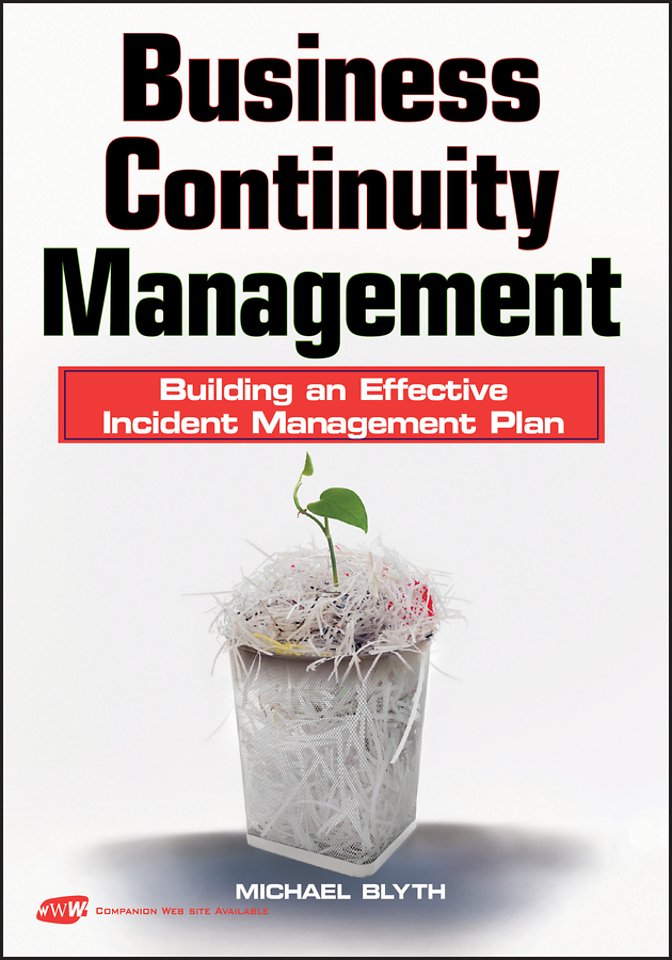Business Continuity Management
Building an Effective Incident Management Plan
Samenvatting
Geschreven door Michael Blyth - één van 's werelds belangrijkste consultants op het gebied van management - geeft dit boek kostenbewuste ondernemers een gestructureerde, duurzame en geteste blauwdruk voor het ontwikkelen van een geïndividualiseerd en strategisch bedrijfscontinuïteitsprogramma.
Dit boek zet managers, Hr-directors en CEO's aan om niet-financiële crises te managen om zo hun bedrijf en hun werknemers te beschermen.
Specificaties
Inhoudsopgave
The Value
Common Failings
Business Continuity Goals
Defining a Crisis
Mapping Risks
Critical Dependencies
Tactical Risk Evaluations
Determining Risk Tolerances
Incident Response versus Crisis Management
Stages of Incident Management and Crisis Response
Understanding Risk
Immediate Response and Impact Levels
Risk Management
Response Trigger Points
Decision and Authority Matrixes
Business Continuity Management Plans
Resourcing
Structure of a Business Continuity Management Plan
Design and Development
Integrated and Compartmentalized Policies
Reporting and Record Keeping
Implementing the Business Continuity Management Plan
The Communications Plan
Organizational Interface Plans
Medical Response and Repatriation Plan
Public Relations Plan
Resource and Procurement Management Plans
Project Initiation Plans
Business Recovery Plans
Post Incident Reviews
Summary
Chapter 2. Incident Management Plan
Incident Management Versus Crisis Response
Principles Of Incident Management
IMP Risk or Threat Overview
Objectives of the IMP
Incident Management Sequence
Crisis Management Flow
Incident Management Sequencing
Incident Management Stages
Macro and Micro Crises
Understanding the IMP Needs
IMP Design And Implementation
Design and Development
Reviewing and Testing
Adjustment and Implementation
IMP Policies And Procedures
Information Security
Resourcing The IMP
The Incident Management Plan
IMP Policies and Instructions
IMP Cover Letter
Immediate Resource Mapping
IMP Communications and Tactical Resource Plan
Initial Verbal Reporting
IMP Decision and Authority Matrix
IMP Alert States and Trigger Response Plans
Alert Notification Systems
IMP Information Capture Reports
IMP Crisis Response Guidelines
Destruction Plans
IMP Risk Assessments
Summary
Chapter 3. Crisis Management Structures.
Interorganizational Management
Accessing and Managing Data
Supporting Agencies
Response Build-Ups
Crisis Management Structures
Corporate Crisis Response Team
Country Crisis Response Team
Program Incident Response Team
Project Incident Response Team
Special Response Teams
Composition Of Crisis Response Teams
Crisis Management Team Commander
Crisis Team Coordinator
Physical and Risk Security Manager
Technical Security Manager
Special Response Team Leader
Administration Manager
Intelligence or Information Officer
Liaison Officer
Communications Manager
Public Relations Officer
Legal Counsel
Human Resources
Health and Safety
Stress Trauma Advisor
Reception Team Manager
Finance Officer
Investor Relations
Incident Management Structures
Crisis Control Center
Monitoring Crisis Management Programs
Summary
Chapter 4. Scope of Risk.
Security and Safety Awareness
Crisis Management Training
Stages of Disasters
Man-Made Risks
Espionage or Information Security Breach
Kidnap and Ransom
Hostage Situations
Monkey Wrenching (Domestic Terrorism)
Power Blackouts
Road Traffic Accidents
Complaints
Mugging or Robbery
Missing Persons
Civil Unrest
Arrest and Detention
Pending Detention and Exit Denial
Loss of Sensitive or High Value Equipment
Unexploded Ordnance and Mines
Indirect and Direct Fire Attacks
Suspect Calls
Workplace Violence
Threats, Coercion, and Extortion
Facility Intrusion
Chemical, Radioactive, and Biological Threats
Small Arms Fire
Complex or Armed Attack
Medical Emergency
Repatriations
Explosive Attack or Sabotage
Suspect Packages and Letters
Bomb Threats
Vehicle Borne Improvised Explosive Devices
Sabotage
Family Liaison
Media Management
Computer-Related Incidents
Disciplinary Issues
Office Block, Facility, or Hotel Fire
Labor Disputes
Natural Incident Management
Floods
Earthquakes
Pandemics
Tsunamis (Tidal Wave)
Hurricanes and Tornados
Volcanoes
Sandstorms
Landslides
Forest Fires
Summary
Chapter 5. Incident Response Guidelines.
VBIED Incident Management
Incident Management Guidelines
Casualty Incident Management
Incident Management Guidelines
Missing Persons Incident Management
Incident Management Guidelines
Road Traffic Accident Incident Management Data Call
Incident Management Guidelines
Facility Physical Security Breach Incident Management
Incident Management Guidelines
Kidnap and Ransom Incident Management
Incident Management Guidelines
Media Management Incident Management
Incident Management Guidelines
Detention and Arrest Incident Management
Incident Management Guidelines
Hostage Situation Incident Management
Incident Management Guidelines
Suspect Call Incident Management
Incident Management Guidelines
Civil Unrest Incident Management
Incident Management Guidelines
Unexploded Ordnance IED or Suspect Package Incident Management
Incident Management Guidelines
Suspect Mail Incident Management
Incident Management Guidelines
Destruction of Sensitive Materials Incident Management
Incident Management Guidelines
Repatriation Incident Management
Incident Management Guidelines
Domestic Terrorism and Special Interest Groups Incident Management
Incident Management Guidelines
Espionage Incident Management
Incident Management Guidelines
Site Occupation and Sit-Ins Incident Management
Incident Management Guidelines
Sabotage Incident Managemen
Incident Management Guidelines
Demonstrations Incident Managemen
Incident Management Guideline
Exit Denial and Pending Detention Incident Managemen
Incident Management Guidelines
Complaints Incident Management
Incident Management Guidelines
Blackouts and Power Losses Incident Management
Incident Management Guidelines
Loss of Sensitive or High Value Materials Incident Management
Incident Management Guidelines
Indirect Fire and Direct Fire Attacks Incident Management
Incident Management Guidelines
Workplace Violence Incident Management
Incident Management Guidelines
Chemical, Biological, or Radiological Attack Incident Management
Incident Management Guidelines
Complex Attack Incident Managemen
Incident Management Guidelines
Family Liaison Incident Management
Incident Management Guidelines
Office, Facility, or Hotel Fires Incident Management
Incident Management Guidelines
Threats, Intimidation, and Coercion Incident Management
Incident Management Guideline
Mugging or Robbery Incident Management
Incident Management Guidelines
Small Arms Fire Incident Management
Incident Management Guidelines
Floods and Tidal Waves Incident Management
Incident Management Guideline
Earthquakes Incident Management
Incident Management Guidelines
Pandemics Incident Management
Incident Management Guidelines
Hurricanes and Tornados Incident Management
Incident Management Guidelines
Volcanoes Incident Management
Incident Management Guidelines
Sandstorms Incident Management
Incident Management Guidelines
Landslides Incident Management
Incident Management Guidelines
Forest Fires and Bush Fires Incident Management
Incident Management Guidelines
Summary
Chapter 6 Crisis Information Capture Reports
Immediate Verbal Reporting (SAD CHALETS)
Serious Incident Reporting
IMP Risk Assessment Reports
Example Crisis Information Capture Reports
Summary
Index
Anderen die dit boek kochten, kochten ook
Net verschenen
Rubrieken
- aanbestedingsrecht
- aansprakelijkheids- en verzekeringsrecht
- accountancy
- algemeen juridisch
- arbeidsrecht
- bank- en effectenrecht
- bestuursrecht
- bouwrecht
- burgerlijk recht en procesrecht
- europees-internationaal recht
- fiscaal recht
- gezondheidsrecht
- insolventierecht
- intellectuele eigendom en ict-recht
- management
- mens en maatschappij
- milieu- en omgevingsrecht
- notarieel recht
- ondernemingsrecht
- pensioenrecht
- personen- en familierecht
- sociale zekerheidsrecht
- staatsrecht
- strafrecht en criminologie
- vastgoed- en huurrecht
- vreemdelingenrecht







